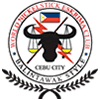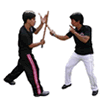Born in 1912, Venancio “Anciong” Bacon would
later become one of the Philippines’ legendary and most influential
eskrimadors in history. He was born in Carcar, Cebu, and moved later to
San Nicolas Town, just outside of Cebu City. He learned eskrima in the
1920s as a teenager. His evolution as an eskrimador began in San
Nicolas. This journey would later lead him to death matches, attacks,
and eventually to jail. But, not all of this journey was dismal. Along
the way, Venancio Bacon made life long friends, and cultivated a loyal
cadre of students, who to this day maintain an affinity incomparable
towards him. Venancio Bacon’s legacy, Balintawak, has become a title
synonymous to Deadly. Balintawak eskrima is Economy, Elegance, Strength,
and Speed expertly woven into one art form. This is the story of Great
Grandmaster Venancio Bacon and the account of his legacy.
In the early 1900s, the Spaniards had just left the Philippines, ending
their 300 year rule. In their place, came the Americans. The vanguard
elite of Cebu still spoke Spanish, while the Americans began to “pacify”
and teach the rest of the Filipinos American English and culture. It
was during this time that Venancio Bacon was born into, a nation in the
midst of change and upheaval. He was born in Carcar, Cebu, but grew up
in San Nicolas Town outside of Ciudad de Cebu, which at that time was
populated by Cebu’s elite upper class. This elite class was made up of
Europeans, Americans, Chinese and mestizo Filipinos. In contrast, San
Nicolas was composed of local Cebuanos and immigrants from neighboring
towns, or from other islands in the Visayas. The people who lived in San
Nicolas were farmers, carpenters, fishermen, peasants, cargadors and
the servants for the City of Cebu’s upper class.
Venancio Bacon began training in the art of eskrima in the 1920s. His
only teacher was Lorenzo “Ensong” Saavedra, of San Nicolas, who during
this time had established the historic Labangon Fencing Club. At a time
when many different styles of eskrima abound, Lorenzo Saavedra’s was
called the Corto Linear, although he was also known to have mastered
other styles. His best students would be Teodoro “Doring” Saavedra, his
nephew, and Venancio Bacon. The two were also very close friends. Both
matured into great eskrimadors, improving each other’s skills and
answering challenge matches that came as a result of their newly
acquired titles. The Labangon Fencing Club eventually dissipated into
oblivion, giving way to a new organization borne out of its ashes.
In 1933, the Doce Pares Club was formed. Headed by Lorenzo Saavedra, the
club was composed of three Saavedra eskrimadors and nine from the
Canete family. This composed the original twelve needed to symbolically
actualize the title Doce Pares, which was taken from a popular roving
play in the Philippines during the late 1800s and early 1900s depicting
the twelve warrior swordsmen of Charlemagne. Another twelve were
inducted to the club soon after, making the initial membership
twenty-four, or Twelve Pairs. Venancio Bacon was among the first
twenty-four. Although there were certain personalities in the club which
ran counter to Venancio Bacon’s own personality, he stayed and carried
his weight as one of its representing eskrimadors.
World War II broke out in the 1940s. With the onset of Japanese
occupation, many eskrimadors became guerilla fighters, employing their
art for the defense of their nation. It was during this time that,
Teodoro Saavedra died at the hands of Japanese soldier-executioners.
Long after the War, in 1952, Venancio Bacon established the club now
known as Balintawak. He finally had enough of the personal bickerings
and internal politics of the Doce Pares club. Along with Vincente
“Inting” Atillo, Delfin Lopez, Jesus Cui, Timoteo “ Timor” Maranga,
Lorenzo Gonzales, Isidro Bardilas, Andres Olaibar, and a few others,
Venancio Bacon began a new club. The newly formed club started training
in the backyard of a watch shop owned by Eduardo Baculi, one of Venancio
Bacon’s students. This shop was located in a small side street in
Colon, called Balintawak Street. The significance of the name Balintawak
evoked the three virtues of strength, courage, and honor befitting that
of the new club. So, from that day forth the word Balintawak would
forever be intertwined with the name Venancio Bacon and to the style of
eskrima which has proven its calculated violence effective time and
again.
Standing at 5 feet, 2 inches tall and weighting no more that 120 pounds,
Venancio Bacon was a very unassuming man. He was a veteran of a great
many death matches in Cebu. Described by many of his students as
lightning fast, Venancio Bacon maneuvered through a fight smoothly while
exploiting his opponents’ balance and coordination. He was known to be
very surgical with a stick, able to employ varying force to his exact
targets throughout his adversary’s body. But, his greatest virtue and
asset was his constant desire to innovate and improve his art,
diligently discovering techniques through the years, never ceasing in
this path. He taught his art to those who desired to learn it.
Among his very first students was Delfin Lopez, a Cebu icon in his own
right. He was a tough cop, a strike breaker, enforcer, and a womanizer.
Delfin Lopez was already an experienced fighter when he met Venancio
Bacon, but he saw something in the small man. Mr. Lopez stood at 5 feet,
10 inches, muscular, easily towering over the diminutive Venancio
Bacon. Testing his strength in a light, friendly match with Venancio
Bacon, Delfin Lopez soon realized the sad reality of his skills as a
fighter. The two men with single sticks faced off, Mr. Lopez took the
offensive and rushed towards his opponent only to be disarmed and
tripped. Having received multiple lashes to his body, Delfin Lopez laid
on the ground, beneath the shadow of Venancio Bacon. The fight only took
a few seconds, but for Mr. Lopez, Venancio Bacon had just won over
another loyal student.
The 1950s and 1960s saw the “Golden Age” of eskrima in Cebu. Eskrimadors
from various camps, mainly the two already mentioned, tested each
other’s skills in all out challenges. These resulted in injuries and
sometimes deaths. Some were under honorable circumstances, while others
treacherous. Vincente “Inting” Carin of Doce Pares found himself
attacked by multiple assailants, incurring various injuries, while
doubly reciprocating lethal injuries on to his attackers. Delfin Lopez
was knifed from behind, placing him in a small lot in Calamba Cemetary.
Venancio Bacon was ambushed in the dark while walking to his home in
Labangon. He killed his assailant. It was during this time that legends
were made and skills were tested. The survivors of this short lived era
have accepted their place in history.
Many Balintawak eskrimadors have carved their names in the walls of
history, forever etched in the halls of time. Some of the more
illustrious of these fighters were Timoteo “ Timor” Maranga, Arnulfo
Mongcal, Jose Villasin, Teodoro “Teddy” Buot, and Teofilo Velez. They
were also the men who would later be responsible for introducing
Balintawak to the rest of the world.
Venancio Bacon was paroled from prison in the mid-1970s. When he
returned to Cebu, he continued to check up on students, making sure the
quality of Balintawak was still up to his standards since he left it.
Mr. Bacon regularly attended training sessions conducted by Jose
Villasin and Teofilo Velez. It was here that Venancio Bacon saw a
glimpse of the next generation of Balintawak fighters. He was satisfied.
Venancio Bacon knew that his old students, Arnulfo Mongcal, Jose
Villasin, Teodoro Buot, Teofilo Velez, and a few others would carry on
the name Balintawak and produce high caliber eskrimadors for years to
come. A few years after, Venancio Bacon died, leaving behind a legacy
now known around the world as Balintawak.
Today, through the efforts of master eskrimadors like
Nick Elizar,
Bobby Taboada, and Nene Gaabucayan, Balintawak is known the world over as one of the most respected styles of eskrima.
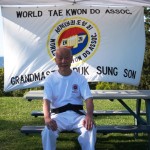
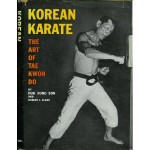
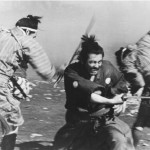










 Escape and Evade
Escape and Evade The Greek Olympic mission in London is celebrating its first medal won by Ilias Iliadis. in Judo.
The Greek Olympic mission in London is celebrating its first medal won by Ilias Iliadis. in Judo. He was born on the 26th of April in 1957 at the Kvemo-Kedi in Georgia. His parents, Moses and Salome, were farmers.
He was born on the 26th of April in 1957 at the Kvemo-Kedi in Georgia. His parents, Moses and Salome, were farmers.




